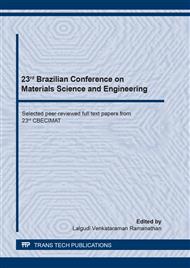p.51
p.57
p.62
p.67
p.73
p.79
p.84
p.89
p.94
Evaluation of Low-Density Polyethylene Thermomechanical and Fractographic Behavior after Ultraviolet Radiation Exposure
Abstract:
Polyethylene (PE) has an exclusive set of properties, such as good toughness and mechanical resistance as well as high flexibility, and ease conformation. However, when exposed to degrading agents, such as heat, humidity and radiation, macromolecular changes can be observed and consequently affect the PE. This work evaluated for the first time the thermomechanical and fracture behavior of low-density polyethylene (LDPE) subjected to degradation at different times of exposure to ultraviolet (UV) radiation. The changes induced in the chemical structure and the highlighted behavior were investigated through thermogravimetric analysis (TGA), differential scanning calorimetry (DSC), Fourier-transformed infrared spectroscopy (FTIR), reticulation content, tensile test, and scanning electron microscopy (SEM). The results suggest that UV radiation modify the failure of the polymer by reducing its crystallinity and dramatically increasing its degree of crosslinking. These modifications impair the LDPE mechanical performance as well as its thermal stability.
Info:
Periodical:
Pages:
73-78
Citation:
Online since:
October 2020
Price:
Сopyright:
© 2020 Trans Tech Publications Ltd. All Rights Reserved
Share:
Citation:


